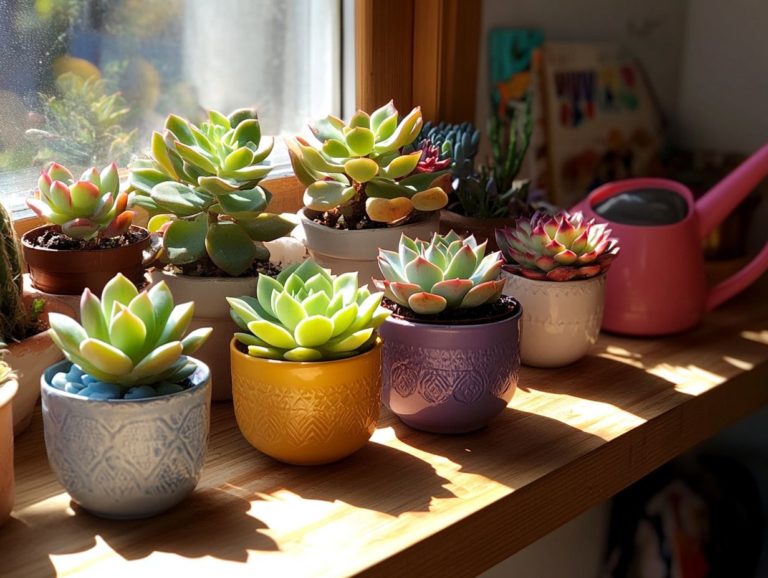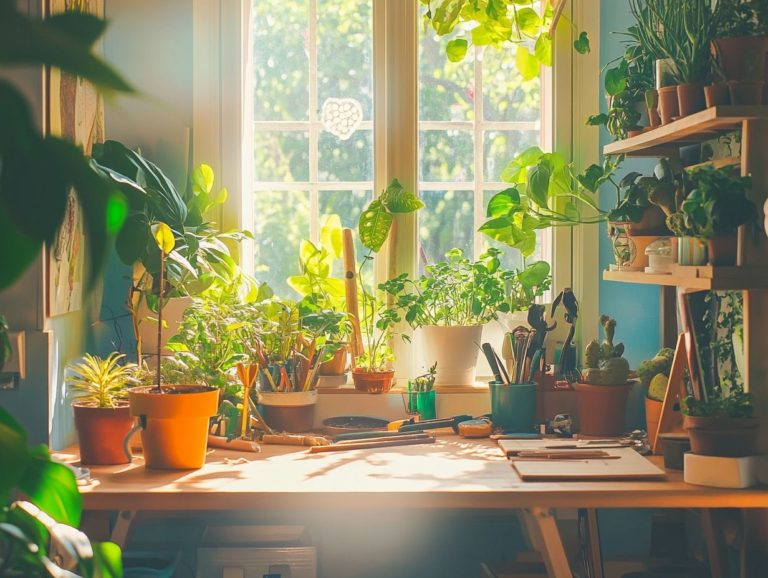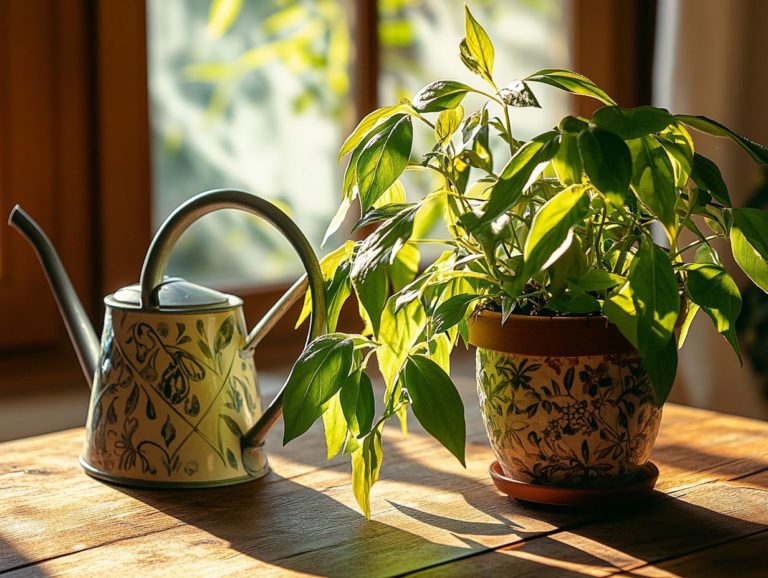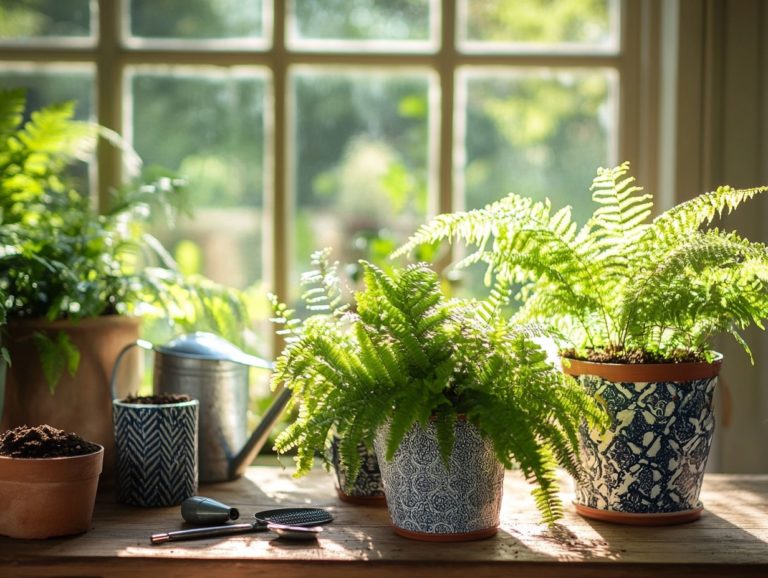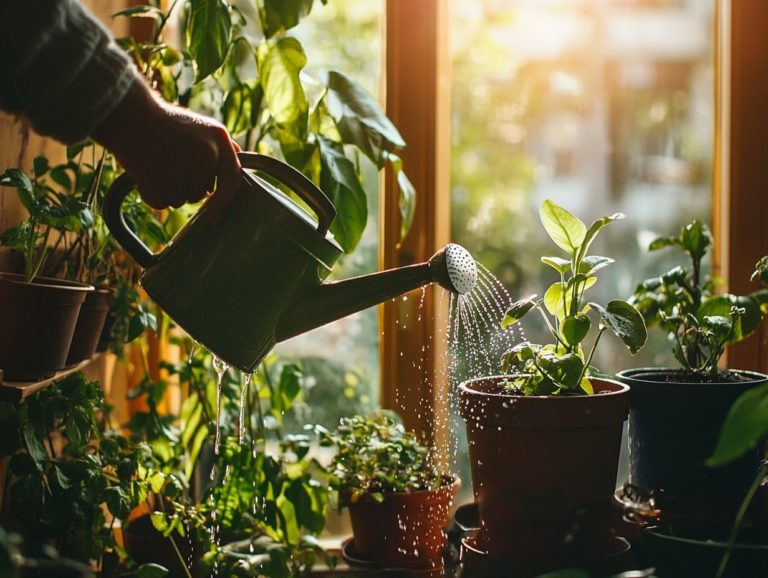What is the Best Way to Water Indoor Plants?
Proper watering is the cornerstone of healthy indoor plants, shaping their growth and vitality in profound ways. But how can you ensure you re providing just the right amount?
This article delves into essential factors that influence watering needs, such as plant type, soil characteristics, and environmental conditions. You ll learn to recognize the signs of under or overwatering and uncover best practices tailored to various plants.
Armed with practical tips for maintaining vibrant greenery, you will be well-equipped to nurture your indoor oasis with confidence and finesse.
Contents
- Key Takeaways:
- Why Proper Watering is Important
- Factors to Consider Before Watering
- Signs of Under or Overwatering
- Best Practices for Watering Indoor Plants
- Tips for Maintaining Healthy Indoor Plants
- Frequently Asked Questions
- What is the Best Way to Water Indoor Plants?
- How often should I water my indoor plants?
- Is it better to water indoor plants from the top or bottom?
- Should I use tap water or filtered water for my indoor plants?
- What is the best time of day to water my indoor plants?
- Is it necessary to fertilize my indoor plants when watering?
Key Takeaways:
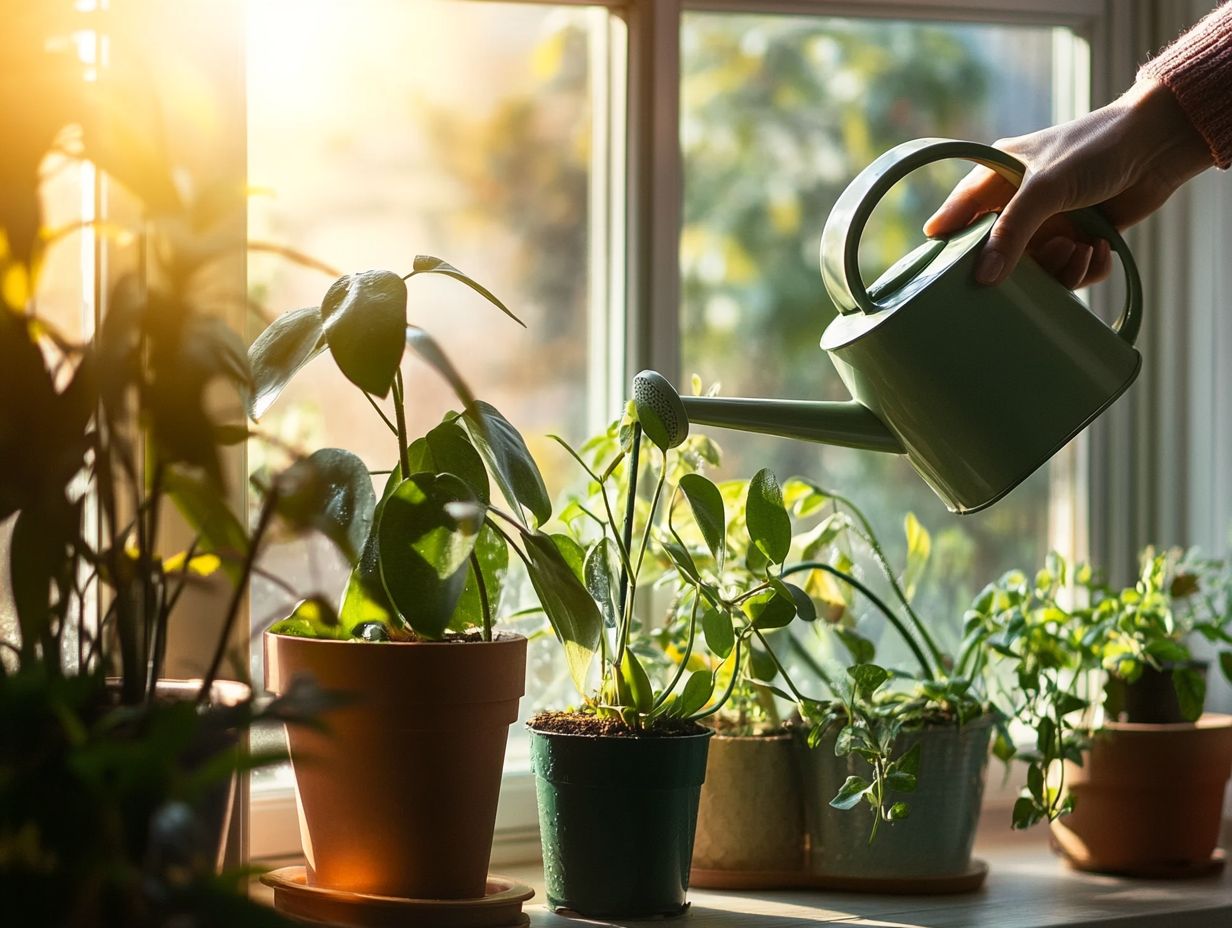
- Water your plants based on their type, environment, soil type, and drainage to prevent problems.
- Look for signs like wilting or discoloration to catch issues early.
- Use proper methods like bottom watering or misting to keep your plants happy.
Why Proper Watering is Important
Proper watering is essential for your indoor plants because it significantly impacts their health and growth. Learning the right way to water your plants can help you avoid common pitfalls, such as overwatering, which can lead to root rot a condition caused by too much water that damages roots and leads to poor plant health.
Houseplants like Spathiphyllum and philodendrons flourish under the right moisture conditions. Keeping an eye on humidity levels will elevate your watering strategy, ensuring that each plant receives the optimal water quality tailored to its natural environment.
Factors to Consider Before Watering
Before you water, think about these important factors that foster optimal growth. Understanding the unique needs of each plant type such as pot size and soil composition will guide you in establishing the best watering practices.
Adequate drainage holes in your pots are vital to prevent waterlogging and its associated problems. Additionally, evaluating the quality of your water and monitoring humidity levels can significantly boost the health of your houseplants, paving the way for a flourishing indoor garden.
Plant Type and Environment
Different types of plants, such as cacti, succulents, and philodendrons, have unique water needs and environmental preferences that dictate their care. By understanding the natural habitats of these plants, you can replicate optimal conditions in your indoor gardening settings, ensuring each species receives just the right amount of water tailored to its specific requirements.
Take cacti, for example; they thrive in arid, desert-like conditions where infrequent rainfalls require deep watering but allow for extended dry periods. In contrast, while succulents are also drought-tolerant, they may need a bit more moisture due to their growth habits and varying leaf thickness. Then there are tropical plants like philodendrons, which flourish in humid environments and often require consistent moisture and higher humidity levels.
To effectively adapt your watering schedules, consider techniques such as the finger test to gauge soil dryness or using self-watering pots to maintain proper hydration. By closely observing each plant’s growth patterns and responding to their specific hydration needs, you can create a thriving green sanctuary that reflects your care and attention.
Soil Type and Drainage
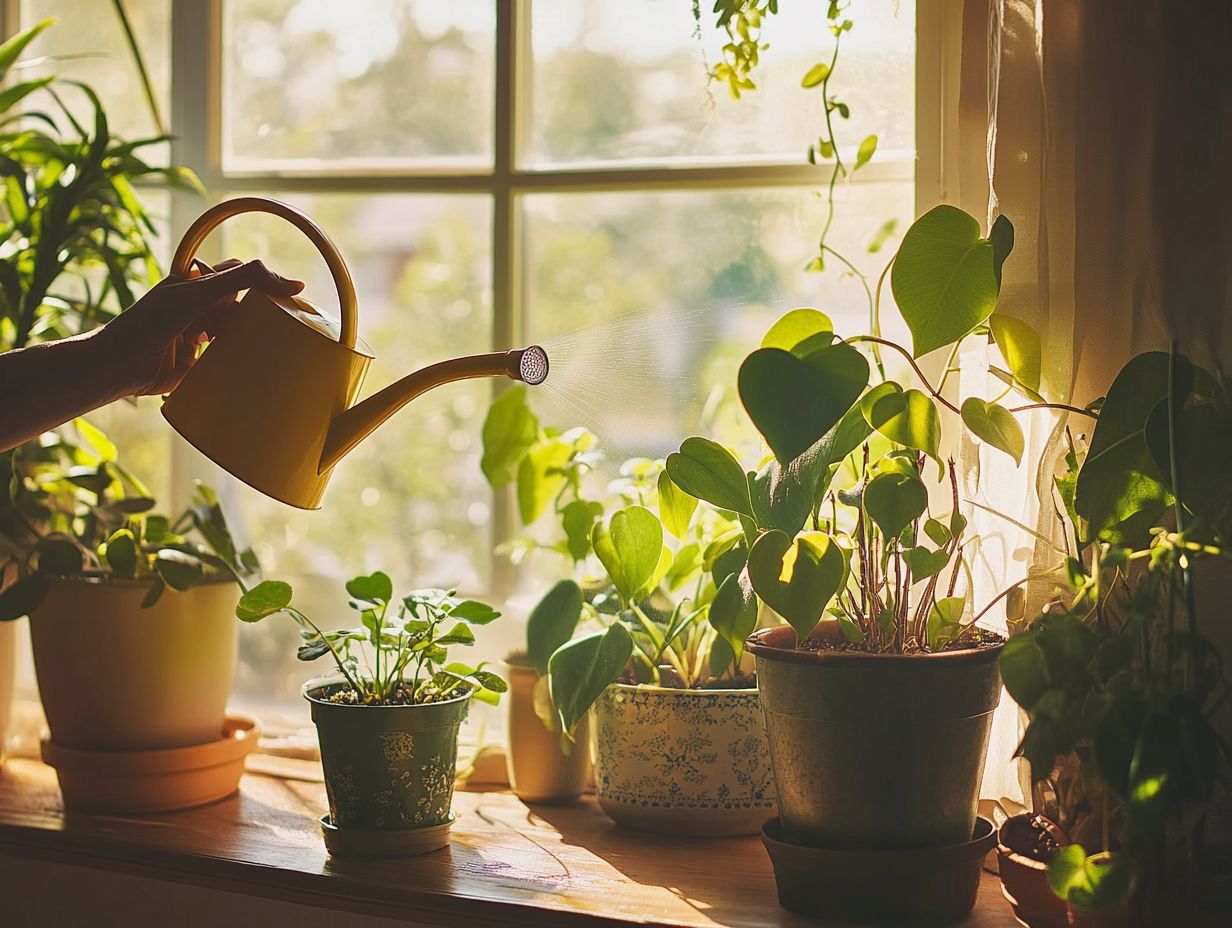
Choosing the right soil for your indoor plants is key. It affects the ability to hold water and drainage, influencing how you water your plants.
Using well-draining soil allows excess water to flow out easily, preventing root rot. Coupled with adequate drainage holes, this can be your best defense against overwatering, which often leads to root rot and other complications tied to poor moisture management.
When selecting the right soil, consider the specific needs of your plants. Some thrive in sandy loam, while others flourish in rich, organic compost. For instance, succulent varieties do best in a gritty medium that encourages quick drainage. In contrast, tropical houseplants typically thrive in heavier, moisture-retaining soil blends.
Understanding how soil composition affects plant health can significantly boost your gardening success. By adjusting your watering routines according to the soil type, you can ensure your plants receive the right hydration without falling victim to soggy roots or drought stress.
Signs of Under or Overwatering
Spotting the signs of under or overwatering can save your indoor plants from disaster.
If you notice yellowing leaves and consistently soggy soil, those are telltale signs of overwatering. Conversely, if your plants are wilting and the soil feels dry to the touch, they may be suffering from underwatering.
An uptick in pests, such as fungus gnats, can also indicate issues with soil moisture levels and watering habits.
Identifying Symptoms
Identifying the signs of watering issues is crucial for effective plant care. Healthy foliage reflects good moisture management.
If you notice brown spots on the leaves or mold forming on the soil surface, it s a clear indication that your plant may be overwatered. On the flip side, if the pot feels unusually light when lifted, that s a sure sign of underwatering, suggesting the soil is too dry.
Utilizing tools such as a moisture meter can greatly assist you in assessing soil moisture levels. This enables you to fine-tune your watering schedule and ensure optimal hydration. Regularly checking your plant s leaves and performing a finger test in the soil will help you maintain that delicate balance, keeping your green companions healthy and vibrant.
Best Practices for Watering Indoor Plants
Implementing best practices for watering your indoor plants is crucial for their vitality and long-term health. Utilizing efficient techniques like bottom watering or top watering can achieve optimal hydration.
Establish a consistent watering schedule tailored to each plant’s unique needs to ensure they receive the adequate moisture necessary for thriving. Consider humidity levels to improve your watering process and provide the best quality water to support robust plant growth.
Timing and Frequency
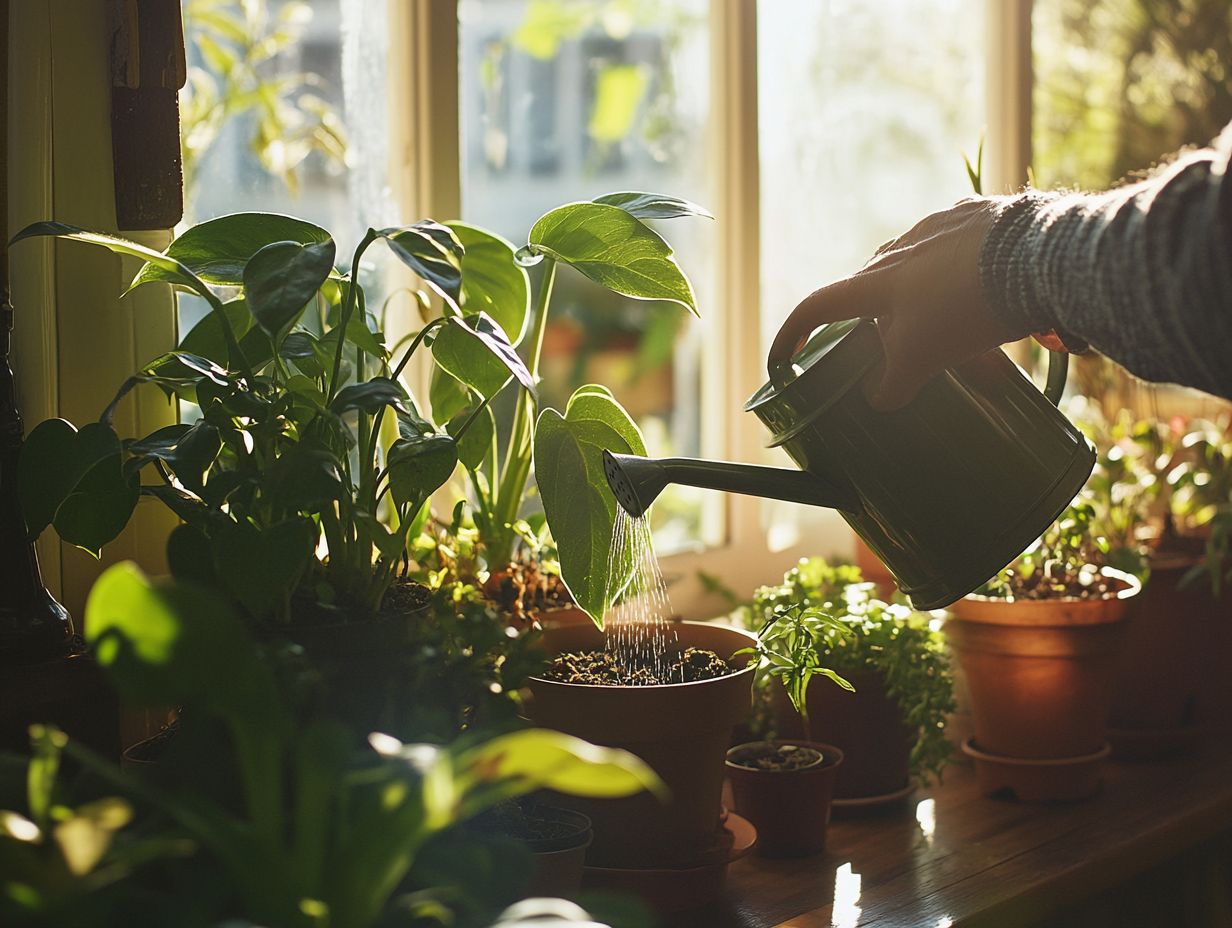
Timing and frequency of watering are crucial in meeting the specific needs of your indoor plants, especially as the seasons shift. Increase the frequency during warmer months and cut back in cooler ones to match your plant’s hydration requirements and the ambient humidity levels.
Understanding the unique characteristics of different plant types can refine your watering strategy. For example, succulents and cacti flourish on minimal moisture and may only require watering every two to three weeks, particularly in warmer seasons. In contrast, tropical plants thrive with more consistent hydration, reflecting their natural, humidity-rich habitats.
As fall and winter approach, the decrease in light signals many plants to enter a dormant phase. This means it s time for a careful reduction in water to prevent root rot. Keeping an eye on soil moisture levels will guide you on when to water. A simple finger test or a moisture meter can help ensure your plants receive just the right amount of hydration.
Watering Techniques
Utilizing effective watering techniques can greatly enhance the health of your indoor plants by ensuring the right amount of moisture in the soil. Bottom watering and top watering are two popular methods that cater to different plant needs. Each offers unique advantages for fostering growth and development.
Your choice between these techniques will depend on the specific type of plant and the environmental conditions in which they thrive. For instance, bottom watering encourages root growth by allowing plants to absorb moisture from the bottom up. This promotes a robust root system. On the other hand, top watering is beneficial for maintaining surface moisture, ensuring the entire soil surface stays adequately hydrated.
It’s vital to know when to use each method. Drought-tolerant plants do well with bottom watering, while those needing frequent hydration thrive with top watering. Factors like pot size, drainage, and air circulation are essential in determining the most effective watering approach for your plants.
Tips for Maintaining Healthy Indoor Plants
To maintain healthy indoor plants, incorporate these key tips into your plant care routine:
- Focus on proper watering techniques.
- Ensure that your pots have adequate drainage holes.
- Monitor humidity levels.
By doing so, you can create the ideal environment for optimal soil moisture and overall plant vitality!
Additional Care and Maintenance
Taking care of your indoor plants goes beyond just watering. It involves understanding their unique growth phases and adapting your care routines accordingly. Consider factors like pot size and humidity levels to create an optimal environment where your plants can truly thrive. Establish a consistent watering schedule.
Successful indoor gardening demands an attentive approach that evolves with your plants’ needs. During the active growth phase in spring and summer, your plants may require more frequent watering and fertilization. Their needs might taper off significantly during the dormant months of fall and winter.
Lighting conditions shift with the seasons! Adjusting your plants’ location to maximize their exposure to natural light is essential. Keeping an eye on indoor humidity levels is also vital. Using a humidifier or misting your plants can greatly enhance moisture levels during dry spells.
By proactively tailoring your care strategies to these dynamics, you can cultivate healthier and more vibrant indoor plants!
Frequently Asked Questions
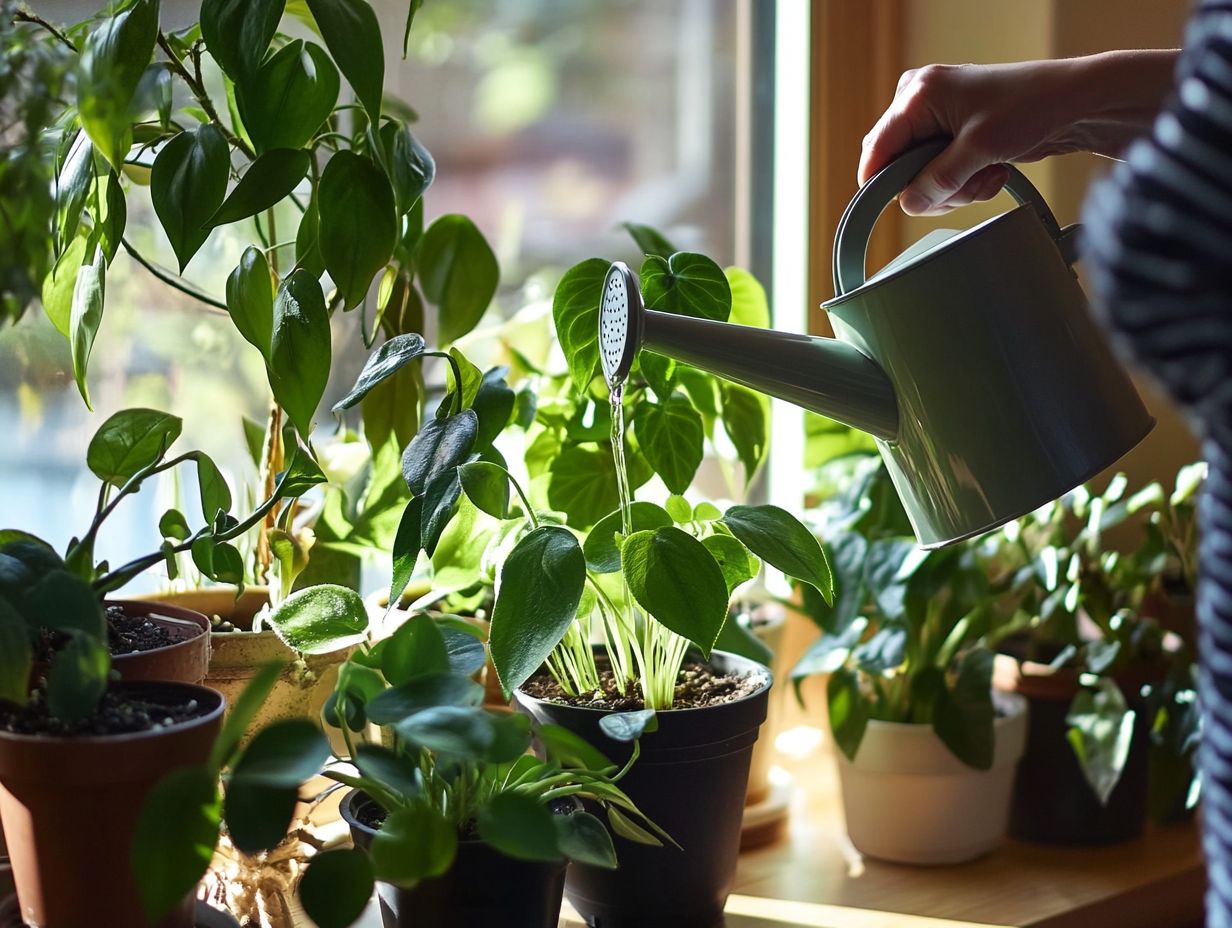
What is the Best Way to Water Indoor Plants?
The best way to water indoor plants is to use room temperature water and pour it directly into the soil until it starts to drain out of the bottom of the pot. This allows the roots to fully absorb the water and prevents over-watering.
How often should I water my indoor plants?
The frequency of watering depends on various factors such as the type of plant, the size of the pot, and the humidity levels in your home. Generally, most indoor plants require watering once a week. However, it’s best to check the soil moisture level before watering.
Is it better to water indoor plants from the top or bottom?
Water indoor plants from the top for the best results. This ensures that the roots get enough water and prevents any water from sitting on the surface and potentially causing fungal growth.
Should I use tap water or filtered water for my indoor plants?
Tap water is generally safe for watering indoor plants. However, if you have hard water or your plants are sensitive to chemicals, use filtered water. You can also collect rainwater for a natural and chemical-free option.
What is the best time of day to water my indoor plants?
The best time to water indoor plants is in the morning. This allows the plant to absorb the water throughout the day, and any excess water will have a chance to evaporate. Avoid watering at night, as this can create a moist environment that promotes fungal growth.
Start implementing these watering techniques today, and watch your indoor plants thrive!
Is it necessary to fertilize my indoor plants when watering?
You don’t need to fertilize your indoor plants every time you water. Using too much fertilizer can harm your plants.
Follow the instructions on the fertilizer packaging. It’s best to fertilize once a month or only when needed.

